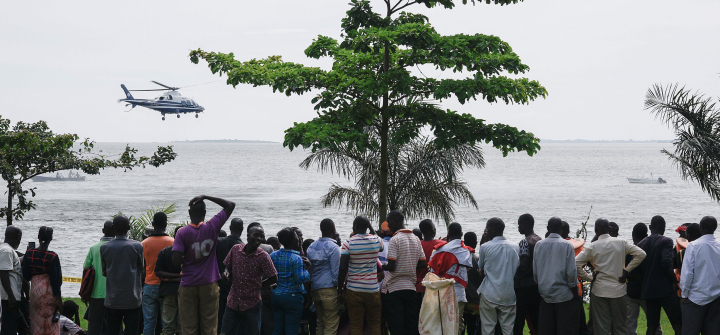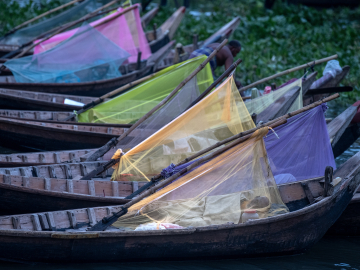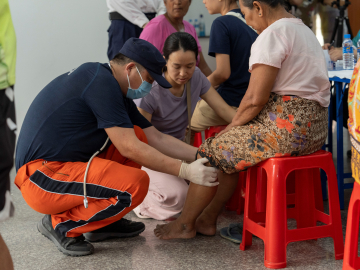The Push to Prevent Drownings in Uganda
KAMPALA, Uganda—On a warm day this past July, Owen Ntanda and three friends set off by boat for Beach House, an entertainment venue along the shores of Lake Victoria. With 4,828 kilometers (3,000 miles) of shoreline stretching across Kenya, Tanzania, and Uganda, the lake is the world’s second-largest body of fresh water. Along the way, Ntanda and one of his friends decided to jump in for a swim.
The decision proved deadly for Ntanda, who drowned that day—even though the 18-year-old boat operator was a good swimmer, and the waters were calm. Paul Kiryowa, a friend and co-worker, believes that Ntanda just got tired while swimming because they were in the water for a long time—at least two hours.
But Lake Victoria has been called one of the “most dangerous stretches of water” in the world. And climate researchers predict that severe storms over the lake are likely to intensify in the coming years, Nature documents, increasing the hazards.
“Here, we say the waters have no friend,” laments Kiryowa.

Paul Kiryowa (in red) helps a woman boarding a passenger boat in Ggaba landing site on Lake Victoria, Uganda. Esther Nakkazi
3,000–5,000 fishermen die every year on the lake, the International Federation of Red Cross and Red Crescent Societies estimates, while a 2021 study by researchers at Makerere University and the CDC, funded by Bloomberg Philanthropies, estimates a drowning death rate for Uganda at 8.5 per 100,000 population per year—translating to an estimated 2,942 drowning deaths each year.
Globally, children are the most affected demographic, per PAHO. But in Uganda, young adults ages 20–39 are the most affected, according to Makerere University’s research. Many die while working. Additionally, men in Uganda are three times more likely to drown than women—primarily because men are more involved in fishing activities.
“It is sad that drowning in Uganda occurs mostly among a very productive age. The fact that these people are drowning when they are at work should raise concern,” says Frederick Oporia, an injury epidemiologist and the director of Trauma, Injury and Rehabilitation at Makerere University’s School of Public Health who was an author on the Makerere University/CDC study.
Drowning, labeled an underrecognized but lethal public health issue by the WHO, has caused over 2.5 million deaths in the last decade, with an estimated 322,000 drowning deaths each year—and an alarming 90% of these fatalities occur in low- and middle-income countries. The WHO African region suffers some of the highest age-standardized drowning death rates in the world, with eight of every 100,000 deaths attributed to a drowning-related incident each year.
Uganda’s drowning cases are also underreported. Only a few draw mainstream media coverage; Ntanda‘s death attracted attention because of the connection to the popular Beach House.

A passenger with a baby boards ablue and white boat at Ggaba landing site. Esther Nakkazi
The fishermen say they do not alert the police to these deaths. Kiryowa estimates that only about four deaths out of 10 are reported. “Many people drown on the lake and no one hears about it. They [police] usually don’t do much anyways,” he says with a shrug.
It took the police three days to recover Ntanda’s body; the fisherfolk claim they would have recovered it faster. “Those marines can’t swim. We are better swimmers. We also have a way of signaling and rescuing each other,” says Kiryowa, explaining that if you go alone on the lake and an engine fails, you just call someone if you have a mobile phone or stand up on your boat and wave a white jerrycan. “Everyone at the landing site knows that is a distress call, and they will immediately come and rescue you.”
The high rate of drowning in Uganda is attributed to several causes, including:
The lack of safety gear like life jackets—most of which are substandard: Research shows that the quality of life jackets in Uganda falls far below international standards, and awareness about the drowning problem is very limited. “These jackets can only support a person on the water for an hour, which is better than nothing but still inadequate,” says Oporia.
Overloading cargo boats: According to Kiryowa, cargo boats are involved in most of the drowning incidents—as opposed to passenger boats, which must possess both a license and life jackets for their passengers and are better policed by the authorities.
Worsening conditions related to climate change: In the Kasese district in western Uganda, melting glaciers from the Rwenzori Mountains cause the Nyamugasani River to flood. Other rivers in the region, including the Mubuku and Nyamwamba, frequently flood during heavy rains, displacing people and leading to drownings.
Counterintuitively, the Fisheries Protection Unit (FPU) under the Uganda People’s Defense Forces, which is tasked with enforcing proper fishing methods and protecting fishermen from drowning, is also blamed for causing some drownings.
Since 2019, the government has implemented rigorous regulations to oversee fishing activities, including patrolling and closures of landing sites—measures designed to revive the diminishing fish populations in the lakes. Many of the fisherfolk use monofilament fishing lines and undersized boats, which are illegal. When the FPU shows up, they jump into the lake to evade arrest—and some drown.
“Awareness is key, yet many government departments and ministries are not even aware that drowning is a significant problem,” says Oporia. “When the government is unaware, the public cannot know either.”

A man boards a cargo boat loading passengers and goods at Ggaba landing site on Lake Victoria in Uganda. Esther Nakkazi
Oporia is pleased, however, that Uganda will soon become one of the first countries to implement a national drowning intervention strategy; the Ministry of Water and Environment plans to launch the effort this fall. “The national drowning strategy is a useful document to lobby for resources and for the government to recognize that drowning is an issue,” he says. The strategy, currently being piloted on Lake Albert, features efforts like drowning survivors serving as peer trainers, teaching their colleagues about the safe use of life jackets, says Oporia.
And, several months ago, the Uganda Parliament also established a Parliamentary Forum on Roads and Water Safety and invited public comment. The strategy will involve all concerned ministries (including Health, Fisheries, Education), the prime minister’s office, the Lake Victoria Maritime communications for search and rescue, and various academic institutions, explains Sowedi Sewagudde, the commissioner of International and Trans-boundary Water Affairs in the Ministry of Water and Environment.
With each stakeholder ministry having a mandate and activities to stop drowning, the question is: where is the budget? “We are trying to incorporate these activities in their budgets. Already 60% of the strategy has been implemented,” says Sewagudde, crediting donors including Bloomberg Philanthropies and a $13 million African Development Bank loan for supporting the effort.
Uganda’s Ministry of Health has already established emergency medical services focused on responses to water emergencies, says Maria Nansasi Nkalubo, the ministry’s principal operations officer. The ministry is also building capacity for emergency services, including nationwide training for health workers, and partnering with civil society organizations and NGOs to train communities in first aid response, such as performing CPR. “People here often press the stomach [rather than the chest], so we are trying to demystify local beliefs about managing drowning cases and teach life-saving skills,” Nkalubo adds.
The government is also addressing the transportation of the sick and injured. The Ministry of Health determined that 20 water boat ambulances are needed and has procured 14 so far, to be distributed across different water bodies, Nkalubo says. These ambulances will not only handle drowning cases but help pregnant mothers access care.
Esther Nakkazi is a science journalist based in Uganda.
Ed. Note: The idea for this story came from Kyra Guy, MPH, a PhD student at the Keck School of Medicine of the University of Southern California. Guy, who has worked in the drowning prevention space, conducting research and implementing community-based water safety education in Uganda, won an honorable mention for her entry, "Drowning Prevention in Uganda, Where Drowning Deaths Are Amongst the Highest in the World" in the Untold Global Health Stories of contest, co-sponsored by Global Health NOW and the Consortium of Universities for Global Health.
This article is part of Global Health NOW’s Local Reporting Initiative, made possible through the generous support of loyal GHN readers.
Join the 50,000+ subscribers in 170+ countries who rely on Global Health NOW summaries and exclusive articles for the latest public health news. Sign up for our free weekday newsletter, and please share with friends and colleagues.
Bystanders watch rescuers search the site of a capsized cruise boat on Lake Victoria near Mutima village, south of Kampala, Uganda. November 25, 2018. Isaac Kasamani/AFP/Getty




